Proper preparation of grapes for winter will protect it from the cold and pests. Despite the fact that most of the varieties were obtained as a result of selection, one should not rely 100% on the ability of sweet berries to resist the influence of external negative factors. Proper preparation of grapes for wintering involves several stages. The first start in the fall. The specific term is determined by the gardener, taking into account the climatic zone and the characteristics of the variety. The optimal time is mid-September - early November. In the middle lane, training begins in October.
Content
Autumn preparation of grapes for winter
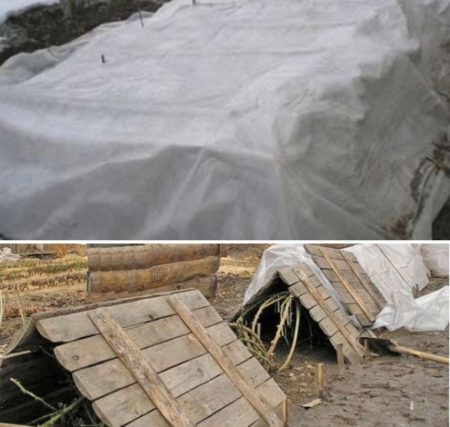
The first step is to gently bend the vine to the ground before the onset of cold weather. The next step is the introduction of nutrients. The gardener must remember the need for fertilizing grapes before shelter for the winter after fruiting is completed. You should not save, otherwise there will be no active vegetation in the spring. Phosphorus and potassium are often used. In those cases when mineral fertilizers are used in the garden, superphosphate is added to the soil in a volume of up to 30 g for every 1 m2. If the bet is on potash fertilizers, then potassium sulfate is added to the soil in a volume of up to 20 g for every 1 m2.
Regardless of the type of fertilizer, bet on wet root dressing. With its help, nutrients quickly reach the goal. For each plant they spend 10 liters of water in which fertilizers are dissolved. In summer cottages, the owners of which prefer organic fertilizers, use wood ash as a top dressing. Each plant spends up to 200 g. It is applied in dry form during digging or in dissolved form. In regions with harsh climates, slightly rotted humus or compost is additionally used. Each plant needs to be processed 15 kg of substances.
Mandatory application of fungicides
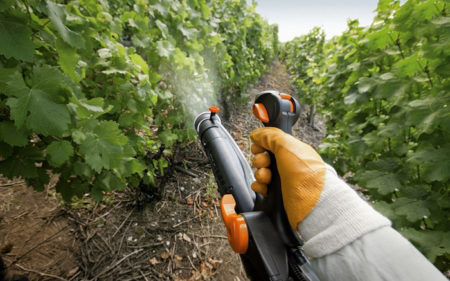
Among the tips on how to prepare vine bushes for winter in the middle lane, the recommendation to use one of the fungicides is not the least. The first place among the popular substances is iron sulfate. It contains substances that prevent the development of bacterial flora. Even with temperature jumps, nothing threatens the berries. When processing seedlings adhere to the following recommendations:
- spraying can be carried out before trimming, but for such a procedure you will need 50% more solution;
- processing is carried out with a 3% solution (if the berries were not sick) and a 5% solution if the grapes are ill;
- for every 10 liters of water take 500 g of the substance;
- it is allowed to treat young plantings with a 1% solution of iron sulfate - for every 10 liters of water they take 100 g of the substance;
- after processing the vine will darken a little and this is not scary;
- Urea (100 g for every 5 l) added to the solution will help improve the quality of spraying.
Despite the fact that urea contains nitrogen, in small quantities it destroys pest larvae. Spraying is carried out only after all leaves have fallen. The second condition is that all buds are closed on the bush.
Trimming bushes
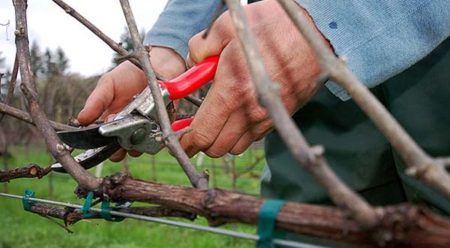
Proper preparation for winter begins with the removal of individual elements. Each action must be verified, so do not rush. Direct grape care in the fall and its subsequent pruning for the winter includes harvesting cuttings. They will be used for breeding berries.You can start working immediately after all the leaves have fallen. It does not matter if the bushes grow only in the first year or several years, the recommended procedure is as follows:
- the first pruning is carried out in mid-September;
- the second pruning is carried out 3 weeks after harvesting in October;
- during pruning I, sick and dry bushes are removed (not more than 15% of the total number of bushes);
- it is allowed to cut only those processes that are localized on the main trunk 60 cm above the upper wire.
Gardeners who want to know how cut grapes for wintershould always keep in mind the variety of berries and climatic features of the region. Both factors shift the trimming time up or down. In order for grapes to feel good in winter, the summer resident pays more attention to pruning II in October:
- pruning to escape from the outside of the sleeve;
- up to 3 kidneys are left on it;
- up to 2 shoots are left on the inside to form a fruit arrow;
- you need to leave such a number of eyes that matches the diameter of the vine + about 2 kidneys.
Compliance with watering rules
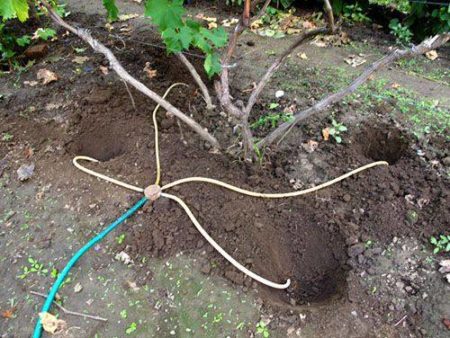
As soon as pruning is completed, the plants need to be watered. The first rule - watering is carried out before the soil freezes, otherwise it does not make sense. The best time is the end of autumn. The more moisture is added, the less likely it is to get a small crop. Reviews of gardeners suggest that a vine soaked with water quickly enters the stage of vegetation in the spring. Late fall preparation includes the following recommendations:
- recommended watering volume for sandy soil - 60 liters for each bush;
- for loams, the indicator is 30 liters for each bush;
- Before watering, a small depression is made around the main stem - up to 10 cm.
Watering is necessary so that the water falls precisely into the groove. Thus, you can save moisture and be sure that each bush has received it enough.
The benefits of baring
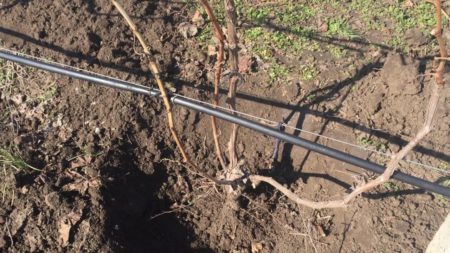
Before winters, you need to remove small roots that are located at a depth of 25 cm. Ignore the recommendation is not worth it. Such roots are too close to the surface. During winter standing, when watering and top dressing are rare, they will die off, drawing strength from the grapes. The surface root removal scheme looks like this:
- carefully dig up the soil around the trunk to a depth of 25 cm;
- remove root pruner;
- treat sections with a solution (3%) of copper sulfate;
- wrap the place of cutting with a film in 3 layers and tie with twine;
- the hole is covered with earth.
Catharization is necessary for those who grow grapes on a farm or in industrial quantities.
Shelter of grapes for the winter
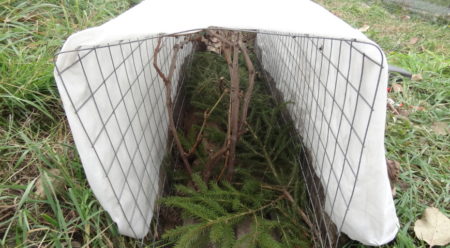
Phased autumn processing of grapes involves a preliminary assessment of the state of the vine. If winter is already on the verge, and the vine is not ripe, then you should temporarily stop watering and feeding. The indicated procedures will be quite enough to accelerate ripening. Next stage - shelter landings. It all depends on the amount of snow that falls in the region. The smaller it is, the denser the fabric should be. Work begins with the careful removal of the manhole from the supports and the binding of branches. Then they are carefully laid on the ground.
Reviews
Tamara
The average temperature in winter falls to -20 degrees. I use potash fertilizers. I do not refuse spraying with copper sulfate in combination with urea. I finish watering in early October, while nature has not shown her temper.
Bogdan
In order for the bush not to be trimmed for a long time, I remove several shoots and spend the Cathar in early October. The leaves are already fallen. Before spraying, I make sure that there are no more open kidneys.
Valeria
Early-growing varieties begin to prepare for winter in mid-September. The leaves fell and the buds closed. First, delete a few shoots. I leave up to 2-3 kidneys. Then I bring in organics. Our winter is mild, so I try not to use chemistry.
Proper processing of grapes in the fall before shelter for the winter will ensure the safety of each bush and the harvest next year. Before starting work, they evaluate the climatic features of the region and the rate of ripening of the variety. As a rule, in the middle lane, training begins in October. It includes pruning, watering and top dressing. In order for the treatment not to be in vain, it is performed before the onset of cold weather. To a greater extent, we are talking about watering. Water simply does not reach the roots if the earth is frozen.

 Non-covering winter-hardy grape varieties for Moscow region
Non-covering winter-hardy grape varieties for Moscow region How to keep the vine in winter
How to keep the vine in winter When can I transfer grapes to another place in the fall
When can I transfer grapes to another place in the fall How to cover and prepare grapes for the winter in the suburbs
How to cover and prepare grapes for the winter in the suburbs